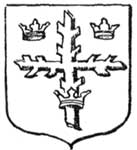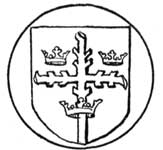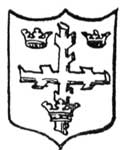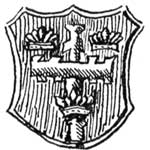Mr. W. Gurney Benham has written an interesting pamphlet called "Ancient Legends connected with the Arms of Colchester," in which the similarity between the arms of that town and those of Nottingham is alluded to. In this pamphlet he states that Colchester claims to be the birthplace, in the year 242, of the Empress Saint Helena, who was daughter of King Coel Godeberg, from whom the town of Colchester takes its name. As is well known, legend credits Saint Helena with being the discoverer of the True Cross and also the bodies of the "Three Kings" (the Magi). The latter she caused to be transferred from India to Constantinople, thence to Milan, and finally to Cologne. The three crowns that appear in the arms of that city are supposed to be indicative of these three kings. A chapel in the cathedral there is dedicated to them, and their remains are said to be contained in a golden casket in the Treasury. In the same way the three crowns in the arms of Colchester are supposed to be commemorative of the birth of the Empress Saint, the reputed discoverer of the kings' bodies. It may naturally be asked, if this be so, why should three similar crowns be introduced with the coat of arms of Nottingham? To this, Mr. Benham furnishes a possible clue. He draws attention to the introduction to Deering's "History of Nottingham," wherein the historian says, "Some to prove the great antiquity of the town of Nottingham affirm that Coelus, a British King, was buried in it A.M. 3831. ..."
In a footnote, Deering explains that this assertion must be regarded as being very unreliable, as there were at least two King Coels, one of whom was father to Saint Helena, whilst another earlier king of that name is reported as the predecessor of King Lucius.
In Leland's "Collectanea," Mr. Benham goes on to say, some unknown author mentions that "Lucius caused four towns to be formed, viz., Nottingham, Hereford (?), Salisbury and Huntingdon." Mr. Benham, like Deering, also admits there is great confusion between the identity of these ancient rulers, but he thinks that the arms of both towns may possibly have been evolved out of these mythical old chronicles, and concludes his pamphlet as follows:—
"On the whole, therefore, I think that we may assume that the arms of Colchester, as of Nottingham, were meant to tell the story of Saint Helena; that the cross alludes to the discovery of the Holy Rood; that the Crowns symbolise the Magi, and that their position was, in all probability, intended to remind men of the third specially important discovery attributed to her (St Helena), the discovery of the Holy nails."
Further theories and conjectures as to the meaning of the arms have been promulgated, such as that the three crowns are symbolical of the Holy Trinity ; that the ragged timber cross is indicative of the proximity of Shirewood Forest, and the three ducal crowns were added by some one of England's king's as a mark of honour to the town, where Royalty so frequently sojourned for the purposes of hunting in Shirewood Forest.
The College of Arms is the final authority on all matters pertaining to the correctness of coat armour; the arms of the city must, therefore, be rendered as laid down by that authority at the commencement of this paper and "continue to be so borne," in spite of the numerous instances in which the arms are depicted in a variant form.
Various representations of the Town Arms prior to 1800.
John Speede's Map, 1610, a cross ragulee couped at all its limbs.
Visitation of 1614, the same, but the limb in pale issues from the base, as shown at the head of this paper. Nottingham halfpenny, 1669, the same as last.
 |
 |
| John Speede's Map, 1610. | Nottingham Halfpenny, 1669. |
Thoroton's History, the same as on Speede's Map. "Nottingham Post" newspaper, 1711, two crossed staves ragulee, the one in pale issuing from the base. " Nottingham Mercury," 1725 (a crude woodcut) the same.
 |
 |
| Thoroton's History, 1677. | Nottingham Mercury, 1725. |
In the vestry of St. Mary's Church {temp. Queen Anne), two crossed staves, but couped at all their limbs.
Descriptions of the Arms.
Guillim's " Display of Heraldry," 1679, cross staves ragulde Papworth's " Armorials," 1874, the same. Burke's " Armory," 1878, the same.
A public-house at the bottom of Malin Hill, now named the "Town Arms," was formerly known as the "Ragged Staff."
The same grant that gave Nottingham supporters to its arms also registered its crest and motto. The crest is thus described:—"On a wreath of the colours, or and gules, a castle walled, triple-towered and domed proper, the dome of the dexter tower surmounted by an increscent argent, and the sinister by an estoile or."
The design of the crest, which is appropriate to the town and its castle, was founded on the seal that has been in use by the corporation for some years. In the seal, however, the moon and star are shown as in the heavens, whereas in the sketch by the College of Arms, issued in 1898, they appear lodged on the pinnacles of the towers of the fortress, a situation which seems scarcely to accord with the blazon in which they are said to surmount them. What is the exact meaning conveyed by the word surmounted? If the heavenly bodies are correctly represented by the College in this crest, as resting on the pinnacles, then it would seem that the estoile in the crest of the Earl of Londesborough and the sun in that of Viscount Powerscourt (to take two instances at random), which are shown as detached and in the heavens in both Burke and Debrett's Peerages, are incorrectly rendered.
As regards the motto "Vivit post funera virtus," Mr. W. H. Stevenson, the editor of the Nottingham Borough Records, published a short pamphlet in 1889 on the subject, in which he shows that the motto is a comparatively recent adjunct (October, 1721) to the arms, and that the majority of ancient cities and boroughs, of which Nottingham can justly claim to be one, have no mottoes. The words certainly seem inappropriate as a motto to a thriving, industrial town.
A letter from Mr. F. W. Dobson, an active member of the council of the Thoroton Society, appeared in the "Nottingham Daily Express" of 8 May, 1906, which seems to fix the period at which a motto first became identified with the town arms. The letter is so convincing on this point that it should be placed on record, and is as follows:
"The association of this motto with the arms of Nottingham has long been a mystery to the local antiquary and historian. It appears to have been assumed, no one knows when or how, but as there is no record of it on the drawing of the arms made at the Heralds' 'Visitation' of the town in 1614, and in the earliest map and prints of the town in which the arms occur, namely Speed (1610) and Thoroton (1677), we are fairly safe in concluding that it is an innovation of the last two hundred years or thereabouts, probably some four centuries later than the first use of the arms themselves.
"We turn, therefore, in the hope of enlightenment, to the local press, and here, fortunately, we have records which give us some assistance.
"In the Castle Museum there is a copy of the earliest Nottingham newspaper, 'The Nottingham Post,' printed by John Collyer in the Long Row. This is dated 1711, and contains on its title page an impress of the town arms without any motto. About 1714 Collyer discontinued this paper, and started 'The Nottingham Mercury,' and we find (from one or two copies of the paper in the possession of Mr. James Ward), that down to the end of 1717, the old block of the arms as used by "The Post" was retained. Copies for the years 1718 to 1720 I have never come across, but in the Free Library there is a copy dated October 19, 1721, and here we find for the first time the arms with the motto adjoining it. We thus arrive at the fact that some time between the years 1718 and 1721 the printer had made a fresh block and added it on.
"Now I suggest, from what we know of Collyer, that so far as its connection with the town is concerned, he was the originator, and that its usage alongside the arms during several years of 'The Murcury's' existence, first gave to it that association with the arms of Nottingham which it holds to-day.
"Mottoes, Mr. Lower says, have been divided into three sorts, the enigmatical, the emblematical, and the sentimental, and ours coming under the last of these, we need not strain its meaning beyond the simple 'virtue survives the grave.'
"Here we have just that vein of sentiment which this God-fearing man, Collyer, the publisher and printer of countless religious books and tracts, the champion of the 'dissenting' interest of those days, would choose as a motto for his paper, and an annex to the arms, and it was probably as the former that he first used and adopted it.
"Still, we may remember, if his intention was to add it to the arms, that he was a noted antiquary, who in the year 1714 had been presented with the freedom of the town 'for his services in collecting antiquities of Nottingham,' and he would know that by so doing he was neither violating any heraldic law, nor assuming any right to which his position as an authority (with the approval of his townsmen) did not entitle him.
"So without any great stretch of imagination, we can picture this worthy printer and bookseller, in his antiquarian rambles amongst the churches of his county, seeing graven on the Stanhope, Clifton, Pilkington, and other noted monuments, this well-known motto, and at a time (1719-20) when his county was plunged in panic, and doubtless many of his fellow townsmen in ruin and despair, owing to the bursting of that great South Sea bubble, choosing it as a suitable and appropriate one. And indeed, in taking it from the tombs of those Nottinghamshire worthies, he was only going back to one of the two sources from which heraldic mottoes probably had their origin—religion and war.
"Until an earlier date of its use be found, I offer this as a solution of the mystery. At any rate, as we cannot lay claim to its authenticity in connection with, our earliest grant or use of arms, there is some satisfaction in surmising that John Collyer, who was probably our only Freeman to receive his honour for eminence as an antiquary, but whose records and researches are altogether lost, left us this motto, which will survive as long as Nottingham bears its arms."
Since Mr. Dobson wrote the foregoing, he has seen some copies of the "Nottingham Mercury" at the British Museum. From these, the earliest use of the motto can be narrowed down to between the dates December 17th, 1719, and June 30th, 1720.
